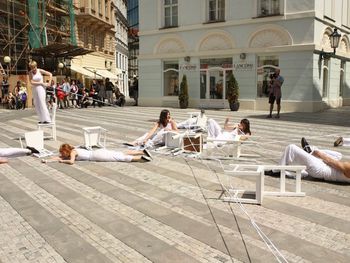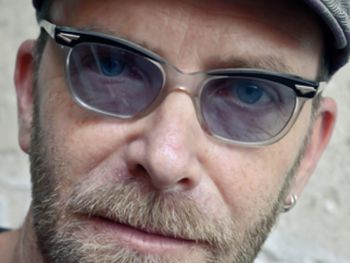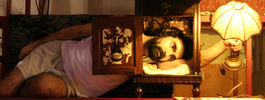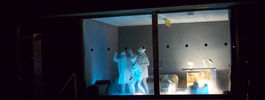Scenarist: Ro Matsušita
We, the members of the Japanese Stage and Television Designers Association, would like to greet you with the opening of the Prague Quadrennial of 1979. We, from the Far East, are very happy to be able to participate
The situation in Japan's theatrical world has remained relatively without change since 1975. However, chronic economic depression due to the oil crisis of 1973 continues to influence all theatrical activities, including our activities as stage designers the financial difficulties seem to be common to all the world.
Our Japanese Stage and Television Designer Association /JASTA/ celebrated the 20th anniversary of its founding last year. This joint organization, which includes both stage and TV designers end is actively supported especially by young TV staff members, is not actually a trade union, but rather an association of free lance artists who work under contracts with producers- It
nevertheless endeavors to improve the status of stage and TV designers, to further mutual contacts among members and to contribute to an improvement of techniques used by members.
In 1977 the TV section of JASTA published the first Yearbook of TV Design in Japan. In 1976 and again in January in this year we organized a "JASTA All-Nippon Interior Design Exhibition "and "The 7th Japanese Stage and TV Design Exhibition“ on an exhibition area of 500 m2 with 152 exhibit panels and 27
models} part of this exhibition will now be shown at the PQ 79. In view of the fact that the 5th OISTT General Assembly has decided to contribute to International Children’s Year, Japanese puppeteers will for the first time participate in the PQ. At present the puppet theatre in Japan is mainly represented by 6 puppet theatre troupes which specialize in the traditional Bunraku puppet theatre. More than 100 puppeteers are members of the Japanese Puppet Artists Association and half of these are members of UNIMA, the international puppetry organization and thus contribute to international exchanges in this field. The PQ 79 participants from Japan are M. Sakurai, T. Hoshino, S.Yoshida, K. Takedy, Y. Tanaka, S. Uchiyama, K. Kawamoto, B. Noda and H. Táni.
The PQ stage design exposition is this time characterized by the participation of the young generation of artists, born in the fifties, such as K. Hoshino /stage designs/, R. Komine /costume designs/, H. Wada /stage designs for opera/, H. Hatano /stage design/. Also for the first time TV designers who are active both in TV broadca8ting and in designing for the stage, such as M. Okada, K. Nemoto, A. Sahara, Y. Mihara and H. Takahashl will participate.
S. Askura, K. Kanamori and I. Takada, a talented trio in the AKT group, are well-known for their interesting work for drama, opera and musical productions, both in large and small theatres. In addition, Kanamori also works for the Japanese OISTT section as its secretary general. S. Kawamori is the winner of a Gold Medal at the PQ 75 and he will also exhibit his outstanding designs at the PQ 79. The name of K. Nishimara, who designs costumes for local theatres, and those of T. Magofuku, Y. Ishii, Y. Soňo and R. Matsuahita, who all design interesting stage sets for modern drama and for musicals, should not be overlooked.
On the other hand T. Tada, S. Uchiyama, S. Itesaka and G. Sakamoto play an important role in the field of modern drama in the commercial theatre, as well as in the experimental theatre of various regions. T. Maeda is well-known as a professional designer for modern dance productions.
At present JASTA has 110 stage designers and 150 TV art designers among its members. At the 5th OISTT Congress, JASTA was elected as one of the countries whose representative serves on the Executive Committee.
We, the members of JASTA, should like to express the wishes of the Far East to improve international understanding and friendship in harmony with our slogan “with the Theatre for Peace and Mutual Understanding ".
- Kazue Hatano
Additional information: Born in 1947, a graduate of the Waseda University. In the years 1974-76 he studied on a Japanese government scholership in Great Britain, at the Royal Shakespeare Company in London and at the National Theatre in London. Among his most interesting stage designs are those for Chekhov' s The Seagull, Gorki ' s The Lower Depths, Brecht' s The Fear and Poverty of the Third Reich and Behan' s The Hostages. He has also designed costumes and stage sets for NHK Television musical programs for children. The Ministry of Education has awarded him a prize for the stage designs for the play The Womb by Juro Miyoshi, the play Dono Isunshin by Kunjiha and for a dramatization of C. Brontë' s Jana Eyre. Now he is on the staff of the Mingei Theatre, a member of JASTA and of OISTT.
Obrázky z katalogu
- Jasuhiro MIHARA (YASUHIRO Mihara)
Specialization: set designer
Additional information: Born in 1937 in Tokyo. Stage designer for the musical programmes of the
Tokyo Broadcasting System, lne. He participated in the PQ in 1971, 1979
and in 1983.
- Setsu Asakura
Additional information: Born in 1922 in Tokyo. Under the influence of her father, who was one of the foremost sculptors in Japan, she began her artistic career as a painter. She now teaches at the Institute of Industrid Design in Kuwazava. Among her most important stage designs are those for productions of Molière' s The Learned Ladies, Brecht´ s Mother Courage and Her Children, Becketť s Waiting for Godot, Sartre' s Dirty Hanods and Y. Fukuda's Where is the Robber Hakamadare? In 1978 she designed the sets for Medea at the Nissei Theatre and for Hamlet at the Teigeki Theatre. In October 1978 she designed the sets and also directed a production of the play by Taeko Tomioko, The Puppet Sisters, which was also played in the USA /in New York, San Francisco, Santa Fe and Dallas/ and which was very favourably received by critics. Among those who played in this production were Kazuko Yoshiyuki, Nobuko Miyamoto and Magosaburo Yuki. She is a member of JASTA, of ITI and OISTT. She participated in the Prague Quadrennial in 1971 and in 1975.
Obrázky z katalogu
- Shinji Itasaka
* 1929, Wakayama
Specialization: set designer
Additional information: He graduated from Kyoto University, currently teaches stage art in Osaka University.
He has been working predominantly for the New Drama Theatre and for the Theatre of Traditional Dance.
He is at work as designer of the Yomiuri Broadcasting. His artistic creation can be characterized as neorealistic. To his most important works belong sets to original dances and modern dramatic creation. He is a member of the Japan Stage and Television Artists Association.
In 1971, 1975, 1983, 1987, 1991 and 1995 he participated in the PQ.
- Kaoru Kanamori
Additional information: Ex-Director of the Nissei Theatre, Deputy of the Kanamori Corporation. His most important works are the designs to Cyrano de Bergerac (1964), Undine (1965), The Devil and the Good God (1965), Andromache (1966), The Lark (1967), King Lear (1967) and The Trojan War Will Not Take Place (1969). He is Director of the Japan Stage and Television Artists Association and a member of the SHIKI Troupe, the Contemporary Theatre Association and the Japanese Institute for Theatre Technology.
- Shigeo Kawamori
Additional information: Graduated from the Faculty of Aesthetics at the Imperial University. He is at work in the Costume Department of Haiyuza. His most important works are the designs of theatre costumes to Hamlet, to The Treepenny Opera and to The Marriage of Figaro. He is a member of the Japan Stage and Television Artists Association.
- Tetsuhiko Maeda
Additional information: Born in 1937 in the province of Akita. He graduated from the Faculty of Architecture at the Polytechnical University in Musashimi. His stage and costume designs are characterized by a complete freeing of the means of expression used by the dancer as a consequence of the use of very original costumes and by an enlivening of theatrical space in an atmosphere which alters the audience´s perception of reality. Among his best designes, for which he was awarded the Prize of the Japanese Festival of Art, are The Holy Family in 1967, Symposium in 1967 and the Celebra- tion in 1968. In his creative work he continues to endeavour for close links between the dancer and the stage set. At present he is the director of the firm Sigma Designs Co. and a vice-president of MOM Design Co. He is a member of JASTA and of OISTT.
- Takehisa Magofuku
Additional information: Graduated from the Tokyo Industrial College. He was at work at the Japan Broadcasting Corporation (NHK). At present he acts as free-lance stage designer. His most important designs are the stage sets to the plays We Are Not an Angel and The Stork. The characteristic feature of his works is an expressive realism of his stage settings.
- Hachiro Nakajima
Additional information: Born in 1923 in Tokyo. Since 1946 he has been working as a stage designer at the Tokyo Stage Design Workshop Kisaku Ito. He designs sets for traditional Japanese theatres, including the Kabuki theatre. He participated in the PQ in 1971, 1975, 1979 and in 1983.
- Tadahiro Tada
Additional information: Born on the island of Hokkaido. After graduating from the Theatrical Faculty of the Nihon University, where he studied under stage designer Yoshida Kenkichi who was strongly influenced by expressionism, he designed several sets in this manner, but later purposely digressed from this artistic style. He became a designer for the NHK Television Company and at present is the chief of the JASTA chapter on the island of Hokkaido. As a designér he devotes his energies to the revival and development of theatrical space by stage action. He is a member of JASTA and OISTT.
- Michiya Okada
Additional information: Born in 1934; he graduated from the University of Neiji. He is now on the staff of the Asaka Radio and Television Company. He is a member of JASTA and OISTT.
- Hiroši HATANO
Additional information: Born in 1940. Already as a student at the Tokyo Geijitsuzai Theatrical School he worked as an assistant with Tomoyoshi Murayama, Ro Matsushita and Akira Sono. He has designed the stage sets for approximately 40 productions; the most recent include Miller' s The Crucible, Shakespeare' s A Midsummer Night's Dream and The Diary of Ann Frank by Goodrich and Hackett. He now is on the staff of the Gijitsuzai Theatre in Tokyo and a member of JASTA and of OISTT.
Obrázky z katalogu
- Keiko HOŠINO
Additional information: Born in 1951. She graduated from the Gakushuin University where she specialized in the study of philosophy and literature, with a diploma thesis on art. Mostly she works for small theatres . She designs for a wide scope of events including for instance fashion shows, various social events, concerts, as well as commercial films for television. Her most successful stage designs include sets for Syng' s The Playboy of the Western World in 1977, produced at the Toh-en Theatre. She is a member of JASTA and of OISTT.
Obrázky z katalogu
- Takeši HOŠINO
Additional information: Born in 1933. Since 1960 he is the chief art director of the Puk Theatre. In 1976 he worked at the Tasmanian Puppet Theatre in Australia for some time. In 1977, The Ministry of Public Health awarded him the Prize of the Society for Child Care. He is a member of the Association of Japanese Puppeteers, of Nihon UNIMA and JASTA.
Obrázky z katalogu
- Yasuhiro ISHII
Additional information: Born in 1930 in Tokyo. He graduated from the Waseda University , where he specialized in the history of art. He is a student of Otoya Oda and has designed approximately 70 stage sets. He is a member of JASTA, ITA and OISTT.
Obrázky z katalogu
- Seiji JOŠIDA
Additional information: Born in 1931; he graduated from the secondary school in Chita.
In 1947 he was one of the co-founders of the Kurarute Puppet
Theatre. Since 1972 he has produced modernized versions of the
plays of Monzaemona Chikamatsu, which are a part of the tradi -
tional heritage of the Japanese theatre. He is a member of the
Association of Japanese Puppeteers and of Nihon UNIMA.
Obrázky z katalogu
- Akira KATAOKA
Additional information: Born in 1932. In 1950 he became a member of the Hitomiza Puppet
Theatre for which he has designed many puppets, as well as stage
sets. In the years 1964-1969 and again in 1972-1974 he worked as
a puppeteer and designer for the NHK Television Company. In 1969
he visited Prague as a Nihon UNIMA representative. In 1976 he
held a one-man exhibition of his work in Japan. He is a member
of the Association of Japanese Puppeteers and of Nihon UNIMA.
Obrázky z katalogu
- Kihačro KAWAMOTO
Additional information: Born in 1925 in Tokyo. In 1944 he graduated from the Faculty of Architecture of the University of Yokahama and began to work as an assistant designer for the Toho Film Company. In the years 1952-56 he made five educational film cartoons as a free lance artist. In 1959, together with his friends, he founded a film company which made advertising cartoons for television, as well as a rather large number of puppet films. In the years 1963-64 he studied with Jiří Trnka in Prague. After returning to Tokyo he worked as a puppeteer in the NHK Television Company department of programs for children and youth, where he created for instance the production With Mother. At present he makes car - toons for adults /The Demon in 1970, The Dojoji Temple in 1976/, as well as puppet films for adults /Every Day a Good Day in 1972, Today's Resolutions and Actud Plans in 1976/.
Obrázky z katalogu
- Lily KOMINE
Additional information: Born in 1947. Since 1965 she works for the Skiki Theatre. In
1970 she warked in the shops of the Royal Shakespeare Company
in London. Since 1973 she is a free lance designer and in 1978
she founded a company for theatrical costumes named Lily. Her
most important stage designs were made for Romeo and Juliet at
the Nissei Theatre, King Lear, Oidipus Rex, The Threepenny Opera
and Nikikai' s opera Old Heidelberg at the National Theatre, She
has also collaborated as a designer in the production of modern
No Plays, such as Yoroboshi, Sotoba Komachi, Ayano Tsuzumi and
Hann, written according to Mishima´ s novels. She is a member of
JASTA and OISTT.
Obrázky z katalogu
- Kumazi KUGIMAČI
Additional information: Born in 1906 in Imari. He studied the kabuki theatre with Kanbei Hasegawa IV. He became a set painter for kabuki and banraku , while at the same time beginning to design his own sets for kabuki, as well as for Japanese traditional dances. The performance of Aozoshi Hanano Nishikie at the Mejji - za Theatre in 1951 represents a benchmark in his career; the stage sets designed by him caught the attention of the public by their maximum simplicity. In that same year he became the chief stage designer of the National Theatre. He has also designed a number of productions for various theatres, among them the National Theatre, the Kabuki-za Theatre, the Simbashi-Enbujo, Minami-za, Toho-Gekijo and others. He is a director of Kanai Ohdogu Company. In 1965 he received a Prize of the Japanese Association of Dancers and in 1975 he received an Order of Merit of the IVth degree and an Order of the Sacred Treasure. He is a member of JASTA, OISTT and ITA. He participated in the Prague Quadrennial in 1975.
Obrázky z katalogu
- Keiko MIJAKE
Additional information: She studied architecture at the Nihon Women s University and at the same time studied extra-murally at the Drama School of the Shiki Theatre. After graduation she worked for one year for a construction firm and after graduating from the Drama School she became a member of the Kanamori Company,directed by Kaoru Kamamori. Among her most important stage designs are those for productions of Puccini´s Madame Butterfly, Prokofiev' s Romeo and Juliet, Mozarť s The Magic Flute and The Marriage of Figaro, as well as for Bolero and Carmina Burana.
Obrázky z katalogu
- Kenji NEMOTO
Additional information: Born in 1939 in Tokyo. Since 1964 he has been working as a stage
designer at Fuji Telecasting Co., Ltd.
Obrázky z katalogu
- Kjoko NIŠIMURA
Additional information: Born in 1931; after graduating from the Academy of Fine Arts in Kyoto she became a member of the art department of the Yomiuri Rádio and Television Company in 1955. Among her foremost designs are the costumes for Shakespeare' s The Merchant of Venice, Ibsen' s Hedda Gabler and Takeo Taguchi' s The Ways of a Clever Wife. She has also designed costumes for the modern ballet; her designs are characterized by her adaptation of traditional Japanaese dress for dancers and its modernization. She is a member of JASTA and of OISTT. She participated in the Prague Quadrennial in 1971 and in 1975.
Obrázky z katalogu
- Bokusi NODA
Additional information: Born in 1934; he graduated from the Faculty of Sculptura of the Academy of Art in Tokyo. Since 1954 he is a designer and director at the Puk Puppet Theatre. He is a member of JASTA, Nihon UNIMA and the Association of Japanese Puppeteers.
Obrázky z katalogu
- Gashin Sakamoto
* 1932
Specialization: set designer
Additional information: Born in 1932 in Osaka. Set designer. Graduated from Osaka City University, College of Literature. Currently works as part-time lecturer in Osaka University of Arts, the Department of Stage Arts.
His most important designs are the sets for Wesker' s Chicken Soup with Barley, for M. Yamazaki´s Go-oh Fusa and for many others. He is a member of JASTA and of the OISTT.
He participated in PQ 1975, 1987, 1991.
Obrázky z katalogu
- Mutsunobu SAKURAI
Additional information: Born in 1937; he creates theatre for children and the puppet theatre above all. He is a graduate of the Theatrical Studio of the Nihon University; in 1977 he received a government sholarship to study abroad. He studied at the Puppet Theatre in Stockholm in Sweden. He is a member of JASTA, OISTT and the Association of Japanese Theatres for Children.
Obrázky z katalogu
- Jošiaki SONO (Yoshiaki Sono)
Additional information: Born in 1934. After graduation from the School of Theatrical Art
he has been a member of the Shinkyo Theatre /now the Geijitsuzai
Theatre in Tokyo/ since 1958. He has designed over 120 stage
sets for almost 30 various theatres. Among his most important
designs are sets for Shakespeare' s A Midsummer Nighť s Dream
and The Merchant of Venice, Molière' s The Miser, Chekhov' s The
Seagull and Uncle Vanya and Gogol ' s The Government Inspector. He
has designed sets for drama, opera and musical, as a well as ballet
productions. He is a member of JASTA and of the OISTT.
Obrázky z katalogu
- Hideo TAKAHAŠI
Additional information: Born in 1937 in Osaka. He studied at the Faculty of Industrial Design at the Academy in Kyoto. He is on the staff of the NHK Television Company, where he specializes in musical and entertainment programs. In 1960 he designed the sets for the musical Gen, in 1972 he received a Venice Municipal Prize for his stage designs for the musical Love Comes When the Fish Leave. At present he is the art director of the NHK Television Company.
Obrázky z katalogu
- Kinosuke TAKEDA
Additional information: Born in 1923. Since 1950 he is active in the Takeda Puppet Thea-
tre. He is a member of the Association of Japanese Puppeteers
and of Nihon UNIMA.
Obrázky z katalogu
- Juko TANAKA
Additional information: Born in 1943 in Tokyo; she graduated from the Women's Art School.
She is a member of the Minwa-za Shadow and Puppet Theatre with
which she travels to nursery schools as a puppet and stage de -
signer. She is a member of the Association of Japanese Puppe -
teers and of Nihon UNTMA.
Obrázky z katalogu
- Teruzo TANAKA
Additional information: Born in 1913. He studied graphics at the Polytechnical College in Kyoto. After graduation in 1934 he began to work as a stage technician and painter at the Takarazuka Opera Theatre, while at the same time designing sets for musicals, opera, ballets and traditional dance for theatres in Kansai. Later he devoted his energies especially to those theatres which produce modern drama. In 1970 he both designed the sets and directed the program The Four Japanese Seasons of the Year in the Sanyo Pavillion at the Worlds Fair in Osaka. In the same year he designed the ballet The Life of Flowers. At present he is a professor at the Theatrical Faculty of the Academy of Art in Osaka. He is a member of JASTA and of OISTT.
Obrázky z katalogu
- Hiroši TANI
Additional information: Born in 1926; he graduated from the Technical College in Shimazu. Since December 1949 he is the founder and a member of the Kyo-gei Puppet Theatre, which is celebrating the 30th anniversary of its founding this year. At present he is the art director of this theatre. He also writes plays for puppet theatres, the scenarios for modern dance performances, as well as plays in a one-man performances as an actor. He is a member of the Association of Japanese Puppeteers and of Nihon UNIMA.
Obrázky z katalogu
- Eiji TAWARA
Additional information: Born in 1941; he graduated from the Faculty of Artistic Design at the Academy of Art in Musashina. Now he works for the Nihon Television Company, is a member of JASTA, JADC and of OISTT.
Obrázky z katalogu
- Senkiči UČIJAMA
Additional information: Born in 1929. Stage designer. He has been working predominantly for the Dance Theatre and Drama Theatre in Nagoya.
Obrázky z katalogu
- Sumiko UČIJAMA
Additional information: Born in 1936; she graduated from the secondary school in Hamamatsu.
In 1963 she began to study at the Theatrical School of the
Puk Puppet Theatre, where she remained to work as a designer and
puppet player after her graduation. She also collaborates with
several television companies. In 1968 she obtained the Gold Me -
dal at an exhibition of applied art, organised under the auspices
of the Shufu-ho-tom Publishing Company. She is a member of the
Association of Japanese Puppeteers, Nihon UNIMA. and the Okazaki
Office.
Obrázky z katalogu
- Heisuke WADA
Additional information: Born in 1950 in Hiroshima; since 1970 he has worked for various theatres as an assistant designer. In 1973 he became an assistant designer at the Opera and Ballet Theatre. Then he designed the sets for The Five Thieves and the Old Lady, The Medium and for La Bohème, which were all very positively assessed by critics. At present he is at the Opera and Ballet Theatre. He is a member of JASTA and of OISTT.
Obrázky z katalogu
- Kiyoshi KAWAKAMI
Additional information: Born in 1929 in Tokyo. After graduating from the department of architecture at the Waseda University he studied stage design at the School of Theatrical Arts. Then he worked as a stage director and stage designer. He has been participating in television productions since the beginnings of television. As a stage designer he has also collaborated with the Drama Theatre and designed various public gatherings. At present he is a chief of the art department of the NHK Television Company. He is a member of JASTA and of OISTT.
- Šigeo Okajima
* 1927, Tokyo
Specialization: set designer
Additional information: Set designer, collaborating with Tokyo Engeki Ensemble. He participated in PQ 1983, 1987, 1991.

























































